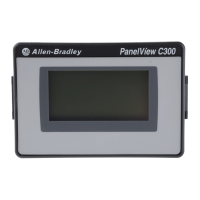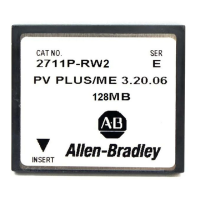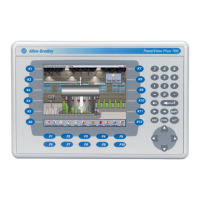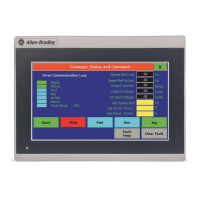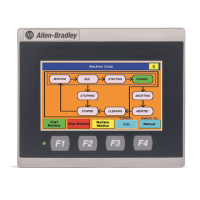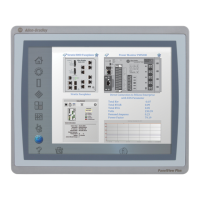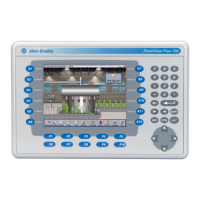Do you have a question about the Allen-Bradley PanelView 2711C-T3M and is the answer not in the manual?
Provides information on key topics of the preface.
Defines target users and required knowledge for the manual.
Lists related publications and how to obtain them.
Explains how to get firmware upgrades and downloads.
Describes PanelView Component terminals as operator interface devices.
Details connecting a computer to the terminal via USB or Ethernet.
Introduces PanelView Explorer as the design environment.
Discusses connecting USB peripherals to the terminal.
Lists available PanelView Component terminals by catalog number.
Explains terminal configuration via design time or runtime interfaces.
Provides access to terminal configuration through a web browser.
Covers adjusting display, language, security, and network settings.
Adjusts the display language of the terminal.
Configures screen brightness and contrast levels.
Sets up screen saver modes, brightness, and timeouts.
Adjusts keyboard repeat rate and delay settings.
Guides on recalibrating the touch screen for accurate input.
Instructions for restarting the terminal without power cycling.
Selects the application that runs on terminal startup.
Adjusts the terminal's current date and time settings.
Configures Ethernet connection and IP addresses.
Restricts user access to terminal configuration screens.
Displays terminal information like firmware and memory status.
Covers transferring, exporting, and deleting applications and files.
Details exporting applications from and importing to terminals.
Recommends validating applications for errors before running.
Describes where to insert the SD memory card in C600/C1000 terminals.
Shows locations for inserting USB flash drives on terminals.
Provides instructions for replacing the terminal's lithium battery.
Provides safety requirements for wiring and installing devices.
Lists cables for connecting PanelView Component terminals.
Details the Ethernet port and its use for communication and design.
Explains the terminal's RS-232 port for serial communication.
Describes USB device and host ports and their uses.
Step-by-step guide to installing the USB driver for computer connection.
Steps to take before starting a firmware upgrade process.
Details installing firmware via USB flash drive or SD card.
Explains how to view terminal system information for support.
Describes terminal alerts, their IDs, and corrective actions.
Guidance on addressing startup issues and observing status indicators.
Lists general attributes like display type, size, resolution, and input.
Details operating temperature, humidity, shock, and vibration specifications.
Lists compliance certifications for the product.
Lists fonts included in the firmware image.
Instructions for setting up fonts using DesignStation 2.0.
Explains how to import Microsoft Windows CE fonts to the terminal.
Provides steps to remove an added font from the terminal.
Introduces the PanelView Component emulator and its file system.
Step-by-step guide to installing the PanelView Component Emulator.
Instructions for removing the PanelView Component Emulator.
Guidance on creating applications with the emulator.
Lists IP addresses for using the PanelView Component emulator.
Lists and explains error codes encountered in the emulator.
Introduces DesignStation 2.0 as offline programming software.
Describes DesignStation 3.0 for designing HMI applications.
Step-by-step guide for installing PanelView Component DesignStation.
Instructions for removing the PanelView Component DesignStation software.
Guidance on creating applications with DesignStation.
Describes the PC application for terminal maintenance via USB.
Step-by-step guide for installing the Firmware Update Utility.
Details updating the firmware image on a non-operating terminal.
Procedures for cleaning the file system and registry.
Troubleshooting steps for problems with the firmware update utility.
Provides information on key topics of the preface.
Defines target users and required knowledge for the manual.
Lists related publications and how to obtain them.
Explains how to get firmware upgrades and downloads.
Describes PanelView Component terminals as operator interface devices.
Details connecting a computer to the terminal via USB or Ethernet.
Introduces PanelView Explorer as the design environment.
Discusses connecting USB peripherals to the terminal.
Lists available PanelView Component terminals by catalog number.
Explains terminal configuration via design time or runtime interfaces.
Provides access to terminal configuration through a web browser.
Covers adjusting display, language, security, and network settings.
Adjusts the display language of the terminal.
Configures screen brightness and contrast levels.
Sets up screen saver modes, brightness, and timeouts.
Adjusts keyboard repeat rate and delay settings.
Guides on recalibrating the touch screen for accurate input.
Instructions for restarting the terminal without power cycling.
Selects the application that runs on terminal startup.
Adjusts the terminal's current date and time settings.
Configures Ethernet connection and IP addresses.
Restricts user access to terminal configuration screens.
Displays terminal information like firmware and memory status.
Covers transferring, exporting, and deleting applications and files.
Details exporting applications from and importing to terminals.
Recommends validating applications for errors before running.
Describes where to insert the SD memory card in C600/C1000 terminals.
Shows locations for inserting USB flash drives on terminals.
Provides instructions for replacing the terminal's lithium battery.
Provides safety requirements for wiring and installing devices.
Lists cables for connecting PanelView Component terminals.
Details the Ethernet port and its use for communication and design.
Explains the terminal's RS-232 port for serial communication.
Describes USB device and host ports and their uses.
Step-by-step guide to installing the USB driver for computer connection.
Steps to take before starting a firmware upgrade process.
Details installing firmware via USB flash drive or SD card.
Explains how to view terminal system information for support.
Describes terminal alerts, their IDs, and corrective actions.
Guidance on addressing startup issues and observing status indicators.
Lists general attributes like display type, size, resolution, and input.
Details operating temperature, humidity, shock, and vibration specifications.
Lists compliance certifications for the product.
Lists fonts included in the firmware image.
Instructions for setting up fonts using DesignStation 2.0.
Explains how to import Microsoft Windows CE fonts to the terminal.
Provides steps to remove an added font from the terminal.
Introduces the PanelView Component emulator and its file system.
Step-by-step guide to installing the PanelView Component Emulator.
Instructions for removing the PanelView Component Emulator.
Guidance on creating applications with the emulator.
Lists IP addresses for using the PanelView Component emulator.
Lists and explains error codes encountered in the emulator.
Introduces DesignStation 2.0 as offline programming software.
Describes DesignStation 3.0 for designing HMI applications.
Step-by-step guide for installing PanelView Component DesignStation.
Instructions for removing the PanelView Component DesignStation software.
Guidance on creating applications with DesignStation.
Describes the PC application for terminal maintenance via USB.
Step-by-step guide for installing the Firmware Update Utility.
Details updating the firmware image on a non-operating terminal.
Procedures for cleaning the file system and registry.
Troubleshooting steps for problems with the firmware update utility.
| Brand | Allen-Bradley |
|---|---|
| Model | PanelView 2711C-T3M |
| Category | Touch terminals |
| Language | English |


